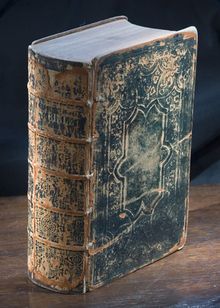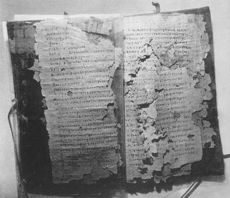Codex

A codex (Latin for block of wood, book; plural codices) is a book in the format used for modern books, with separate pages normally bound together and given a cover.
Developed by the Romans from wooden writing tablets, its gradual replacement of the scroll, the dominant form of book in the ancient world, has been termed the most important advance in the history of the book prior to the invention of printing.[1] The spread of the codex is closely associated with the rise of Christianity which has been using it as the exclusive book format of the Bible almost from the beginning.[2] First described by the 1st century AD Roman poet Martial, who already praised its convenient use, the codex achieved numerical parity with the scroll around 300 AD, and had completely replaced it throughout the now Christianised Greco-Roman world by the 6th century.[3]
The codex holds considerable practical advantages over other book formats, such as compactness, sturdiness, ease of reference and especially economy; unlike the scroll, both recto and verso could be used for writing.[4] Although the change from rolls to codices roughly coincides with the transition from papyrus to parchment as favourite writing material, the two developments are quite unconnected. In fact, any combination of codices and scrolls on the one hand with papyrus and parchment on the other is technically feasible and well attested from the historical record.[5]
Although technically any modern paperback is a codex, the term is now reserved for manuscript (hand-written) books which were produced from Late Antiquity through the Middle Ages. The scholarly study of these manuscripts from the point of view of the bookbinding craft is called codicology, while the study of ancient documents in general is called paleography.
Contents |
History

The Romans used precursors made of reusable wax-covered tablets of wood for taking notes and other informal writings; while codices of parchment or papyrus appear to have been widely used as personal notebooks, for instance in recording copies of letters sent (Cicero Fam. 9.26.1). The pages of such notebooks were commonly washed or scraped for re-use; and consequently writings on codex were considered informal and impermanent.
The first recorded Roman use of the codex for publishing and distributing literary works dates from the late first century AD, when Martial experimented with the format. At that time the scroll was the dominant medium for literary works and would remain dominant for secular works until the fourth century. Julius Caesar, traveling in Gaul, found it useful to fold his scrolls concertina-style for quicker reference, as the Chinese also later did.

As far back as the early 2nd century, there is evidence that the codex—usually of papyrus—was the preferred format among Christians: in the library of the Villa of the Papyri, Herculaneum (buried in AD 79), all the texts (Greek literature) are scrolls; in the Nag Hammadi "library", secreted about AD 390, all the texts (Gnostic Christian) are codices. The earliest surviving fragments from codices come from Egypt and are variously dated (always tentatively) towards the end of the 1st century or in the first half of the 2nd. This group includes the Rylands Library Papyrus P52, containing part of St John's Gospel, and perhaps dating from between 125 and 160.[6]

In Western culture the codex gradually replaced the scroll. From the fourth century, when the codex gained wide acceptance, to the Carolingian Renaissance in the eighth century, many works that were not converted from scroll to codex were lost to posterity. The codex was an improvement over the scroll in several ways. It could be opened flat at any page, allowing easier reading; the pages could be written on both recto and verso; and the codex, protected within its durable covers, was more compact and easier to transport.
The codex also made it easier to organize documents in a library because it had a stable spine on which the title of the book could be written. The spine could be used for the incipit, before the concept of a proper title was developed, during medieval times.
Although most early codices were made of papyrus, papyrus was fragile and supplies from Egypt, the only place where papyrus grew and was made into paper, became scanty; the more durable parchment and vellum gained favor, despite the cost.

The codices of pre-Columbian Mesoamerica had the same form as the European codex, but were instead made with long folded strips of either fig bark (amatl) or plant fibers, often with a layer of whitewash applied before writing. New World codices were written as late as the 16th century (see Maya codices and Aztec codices). Those written before the Spanish conquests seem all to have been single long sheets folded concertina-style, sometimes written on both sides of the local amatl paper. So, strictly speaking they are not in codex format, but they more consistently have "Codex" in their usual names than do other types of manuscript.
In the Far East, the scroll remained standard for far longer than in the West. There were intermediate stages, such as scrolls folded concertina-style and pasted together at the back and books were printed only on one side of the paper.[7] The Jewish religion still retains the Torah scroll, at least for ceremonial use.
Bookbinding
Among the experiments of earlier centuries, scrolls were sometimes unrolled horizontally, as a succession of columns. (The Dead Sea Scrolls are a famous example of this format.) This made it possible to fold the scroll as an accordion. The next step was then to cut the folios, sew and glue them at their centers, making it easier to use the papyrus or vellum recto-verso as with a modern book. In traditional bookbinding, these assembled folios trimmed and curved were called "codex" in order to differentiate it from the "Case" which we now know as "Hard cover". Binding the Codex was clearly a different procedure from binding the "Case". This terminology still in use some 50 or 60 years ago has been nearly abandoned. Some commercial bookbinders may refer to the cover and the inside of the book instead, but, a few others, attached to their traditions still use the terms Codex and Case.
See also
- List of codices
- List of New Testament papyri
- List of New Testament uncials
- Aztec codices
- Maya codices
- Traditional Chinese bookbinding
- History of books
References
- ↑ Roberts & Skeat 1983, p. 1
- ↑ Roberts & Skeat 1983, pp. 38−67
- ↑ Roberts & Skeat 1983, p. 75
- ↑ Roberts & Skeat 1983, pp. 45−53
- ↑ Roberts & Skeat 1983, p. 5
- ↑ Turner The Typology of the Early Codex, U Penn 1977, and Roberts & Skeat The Birth of the Codex (Oxford University 1983). From Robert A Kraft (see link): "A fragment of a Latin parchment codex of an otherwise unknown historical text dating to about 100 CE was also found at Oxyrhynchus (POx 30; see Roberts & Skeat 28). Papyrus fragments of a "Treatise of the Empirical School" dated by its editor to the centuries 1-2 CE is also attested in the Berlin collection (inv. # 9015, Pack\2 # 2355) - Turner, Typology # 389, and Roberts & Skeat 71, call it a "medical manual.""
- ↑ International Dunhuang Project - Several intermediate Chinese bookbinding forms from the C10th.
Sources
- David Diringer, The Book Before Printing: Ancient, Medieval and Oriental, Courier Dover Publications, New York 1982, ISBN 0486242439
- L. W. Hurtado, The Earliest Christian Artifacts: Manuscripts and Christian Origins, Cambridge 2006.
- Roberts, Colin H.; Skeat, T. C. (1983), The Birth of the Codex, London: Oxford University Press, ISBN 0-19-726024-1
External links
- Centre for the History of the Book
- The Codex and Canon Consciousness - Draft paper by Robert Kraft on the change from scroll to codex
- The Construction of the Codex In Classic- and Postclassic-Period Maya Civilization Maya Codex and Paper Making
- Encyclopaedia Romana: "Scroll and codex"
- K.C. Hanson, Catalogue of New Testament Papyri & Codices 2nd—10th Centuries